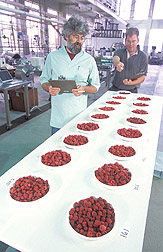ARS: Solving agricultural problems with science. Sci4Kids: Bridging the gap between science, agriculture and you.
 |
There's nothing quite like the sweet taste of a bright red strawberry. You've probably had hundreds of strawberries in your life. You've had strawberry ice cream. You may have gone to a farm where you picked your own fruit. Or, your parents may have given you some they bought at the supermarket. But each one of these strawberries is different. |
| There
are about two dozen There are different berries for different climates. There are also different ones depending on how the berry will be used. Berries with strong colors and flavors are used for ice cream and bakery products. Berries that can be shipped and stored fresh are grown for sale at either the supermarket or small farms. In the past, many berries were only available for a few summer months. Now, you can probably find berries available throughout the year. Chad Finn works at the ARS Horticultural
Crops Research Laboratory in Corvallis, Oregon. He's breeding new blackberries,
raspberries, blueberries and strawberries. Some of the new Breeding a new strawberry takes 10 to 15 years. Think of how old you are now. Finn may have started breeding a berry before you were born, but decided it still isn't good enough for release to growers. |
So, how are berries bred? |
Before
Finn starts working on a new berry, he talks to growers and consumers
to see what qualities they'd like. Then he combines the genes of one
berry--which has some of these traits--with another berry that has other
important traits. |
That
might not sound too difficult--but it's easier said than done. Finn
uses a paintbrush to pollinate
the flowers of the berry
plants. He brushes the male pollen from one plant onto the female flower
parts of another plant--kind of like what bees do with their legs. Believe
it or not, there are male and female versions of many plants, just like
with animals!
Once the pollinated plant's fruit and
seeds are mature, Finn mashes the fruit. He puts the seeds in a greenhouse,
and they start to sprout into seedlings. Finn eventually moves the
After many years of growing the berry plants in test plots, he checks them in various other ways. He may want to see if they are resistant to pests, grow to a particular size, or the berries have a certain color. But most importantly, they need to taste delicious. Eventually, he asks people to taste the berries and choose the best ones. |
Only one out of about every 10,000 seedlings will pass all this testing and be named as a new berry. And only a few of these become widely planted. So, next time you eat a delicious berry, just remember how much "work" it went through to end up in your mouth! |
| David Elstein, Agricultural Research Service, Information Staff | Click to go to top of page. | |
 types
grown each year. "But, over the years, scientists have developed
hundreds of new types of strawberries and other berries, and we are
working to create dozens more," says
types
grown each year. "But, over the years, scientists have developed
hundreds of new types of strawberries and other berries, and we are
working to create dozens more," says  seedlings into
fields, where they can grow to maturity. Every year, he selects the
seedlings that have the best fruit and continues growing them. The
rest are thrown away. Finn only wants "the best of the best."
seedlings into
fields, where they can grow to maturity. Every year, he selects the
seedlings that have the best fruit and continues growing them. The
rest are thrown away. Finn only wants "the best of the best."